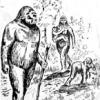Sunflower, that is something that has interested me for years. There are a lot of accounts from rural folks from all over the Southeast who have had overprotective dogs killed, or severely injured gruesomely by basically being skinned alive by bigfoot. On the other hand, bigfoot have accepted the presence of some dogs and have apparently came into physical contact with them peacefully on a routine basis.
While doing field work in South Alabama, reports I investigated indicated both kinds of interactions between the two species was not at all uncommon. It just didn't make sense to me until I talked to several older Black folks who lived in a very rural area of Marengo County fairly close to the Tombigbee River. (I was referred to some of the folks by Black residents of adjoining Clarke County who had talked to me about their own encounters and who had relatives living there.)
When the people in the small community began telling me about BF that routinely came around at night checking for food - scraps from the dinner table and scraps from the butchering of hogs, chickens, goats and deer - they mentioned that sometimes grown dogs would be killed with a club by the bigfoot if the dogs would not back off when the bigfoot approached. The interesting and somewhat amusing thing was that they stated if there were small pups involved, the bigfoot would either let the pups share the food with them, or just stand docilely by and watch the pups eat. They told me that after eating their fill, some of the pups would stay and watch the bigfoot eat. At other times the bigfoot would carry off a small pup, and release it sometimes later. The people said the pups that were picked up by the bigfoot, or one that followed the bigfoot off into the wood line, would return that night or the next day "smelling worse than a pan of burnt collard green and a rotten egg".
That community of people knew one of the male bigfoot from the time it was a baby clinging to its mother's back until it became old, gray and decrepit at the age of about 52. They studiously avoided striking him early in the morning or just before dark with their automobiles at the typical spot on the road leading to the community where he routinely crossed. Just before he was last seen, they stated they would have to come to a near stop to allow him time to cross the narrow road.


